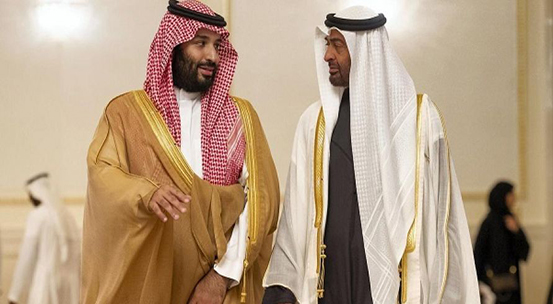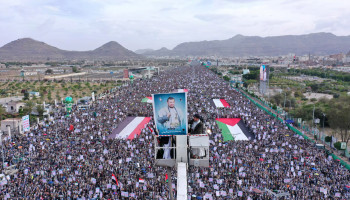Why Doesn’t Saudi-Emirati Bloc Act To End Southern Yemen Conflict?
الأربعاء, 20 مايو 2020

Since the UAE-aligned Southern Transitional Council announced autonomy in the south of the country in late April following accusations against the resigned President Abdrabbuh Mansour Hadi of violating the agreements in Aden and other southern provinces, this part of the country witnessed severe clashes between the two sides.
A peace agreement followed negotiations between the STC and the resigned government in November 2019 in the Saudi capital Riyadh, with the support of the Saudi Crown Prince Mohammad bin Salman and Abu Dhabi Crown Prince Mohammad bin Zayed Al Nahyan. Despite the fact that the two Arab countries acted as guarantors of the peace deal, when the southern separatists violated it, Saudi Arabia stopped short of just asking the STC to return to the accord. In fact, Saudi Arabia and the UAE, both waged the Yemen war with a promise to restore Hadi to the power, did not make any efforts to end the clashes in southern Yemen.
Now the question is that why do Riyadh and Abu Dhabi make no attempts to end the war between the STC and the Hadi government? Are there any bonds between Saudi and Emirati interests in the continuation of the clashes in the south?
The UAE strategy in Yemen war
After joining the Saudi-led Arab coalition against Yemen, the UAE acted in the Arab country with a set of specific strategies:
1. Seeking to dominate southern parts of Yemen, particularly Socotra island. These part of Yemen are of strategic position as they overlook the Gulf of Oman and the Bab-el-Mandeb Strait as the two sensitive and key spots in the regional geopolitics.
2. Recruiting forces from the south and making alliances with the tribes to legitimize its military presence there. The next move was to train and arm them to serve its agendas in southern Yemen.
3. Planning for a short-term stay in Yemen. Abu Dhabi trained and armed the recruited militias and then used them as proxies to pursue its goals in the country. This strategy in addition to cutting costs opened UAE's hand to take measures and decisions outside the framework of the Saudi-headed coalition.
4. Trying to prevent attacks on its soil by the Yemeni Ansarullah Movement, a revolutionary force in control of the capital Sana’a and other northern provinces. The Emirati leaders’ main goals were to push the movement to focus just on Saudi Arabia as a target of its strikes. Having in mind that the UAE is substantially vulnerable to any massive attack by the powerful Ansarullah, Abu Dhabi tried to, mainly using the diplomatic channels with Tehran, dissuade Ansarullah from launching strikes on the Emirati soil.
By pursuing these agendas within its major war strategy, the UAE sought maximized benefits and minimized costs. The split of the south and seizure of Socotra were the top goals and gaining sway over the separatist groups in the south and mainly Socotra were the least goals in the defined UAE strategy. This strategy also sought to cut the costs and damages through trying to minimize the direct military presence time and using the political channels to prevent Ansarullah attacks on its soil.
As it is understood, since the beginning of the crisis in Yemen, Abu Dhabi looked forward to dominating the southern regions. Apparently, its goal is realizable through the split of the south from the north. Thus, a lack of serious attempt by the UAE to end the clashes between Hadi and STC forces is aimed to deepen the crisis and thus materialize the Emirati goals in this sensitive part of Yemen.
Riyadh’s erratic objectives in Yemen war
Just unlike the UAE which since the beginning predicted that the war will be lengthy or at least concluded so after it observed the course of the war developments, Saudi Arabia thought that the war will be won in a short period. As its officials after the start of the war said, the Arab kingdom planned to destroy the opposite side and win the war within less than a month.
Saudi Arabia, which upon the start of the war saw the arrival of new rulers, set a couple of goals to achieve from the anti-Yemeni campaign:
1. Flexing its muscles for its regional rivals especially Iran and seeking to bring about a new regional order by quelling the regional groups affiliated with the Iran-led Axis of Resistance.
2. Fast restoration to power of the ousted President Abdrabbuh Mansour Hadi.
3. Repressing Ansarullah as a key player in Yemen and saving the Yemeni union with the old political structure.
But the Saudis apparently miscalculated, hence not only failing to realize any of their preliminary goals but also not moving close to them. So, the supposition that Saudi Arabia has reviewed its initial goals is never unlikely.
In the present circumstances, the collapse of Riyadh agreement, the increased clashes between the southern forces and Hadi loyalists, and also the reports that Saudi Arabia has asked Hadi and his government to leave Riyadh or pay for the hotels they have been residing in since 2015 by end of May give several possibilities about why the Saudis do not make serious efforts to settle the disputes between Hadi and the STC.
1. Saudi Arabia has been frustrated to see the restoration of power by Hadi especially since last year when the STC gained an upper hand over the Hadi forces and Ansarullah strengthened itself in missile power and also on the battlegrounds. Developing the notion that a unified Yemen in which Ansarullah exists as a deep-rooted and powerful actor in the political structure will never be in the best interests of Saudi Arabia, Riyadh leaders in association with their Emirati allies focused on the partition of Yemen. Saudi Arabia concentrates on taking control of Al-Mahra, a coastal province in eastern Yemen that in a partitioned Yemen can serve as a gate to transfer the Saudi oil to the Arabia Sea and reduce the reliance on oil transfer via the Strait of Hormuz.
2. Five years after the start of the war and the Saudi failure to achieve its announced goals, Riyadh now views Hadi as a burnt piece lacking legitimacy in the south and the north and an obstacle ahead of the negotiations with Sana’a. But Yemeni parties close to Saudi Arabia like Al-Islah, late President Ali Abdullah Saleh loyalists like General Ali Mohsen al-Ahmar, and many tribes are opposed to the split of the country. At the same time, Riyadh is worried about the rise of a new Yemen with Axis of Resistance mindset near its borders. So, it can be said that possibly Riyadh will ignore the capability of the southern forces to defeat the Hadi government in Aden and seize the whole south. It may choose to deal blows to the UAE-backed forces as the conflict unfolds.
Conclusion
What looks clear is that after spending a long time and huge money on its campaign and gaining nothing in return, Saudi Arabia may have decided to recalculate its strategy in Yemen. Whatever the calculation is, it will include driving out of the game the fugitive Hadi. Although Saudi Arabia suffers from economic pressures amid extremely low oil prices, the main reason it told Hadi to pay for his government hotel stay is not the money itself. Rather, it wants to press him to step down from the political scene.
Disappointment with the return of the Hadi government to Sana’a encourages Riyadh to show no sensitivity to bringing the STC and Hadi to a ceasefire. Perhaps the clashes with the southerners serve as a pressure tool in the hands of the Saudis to remove Hadi from the game. This defines why the Saudis are siding with the UAE in a show of no interest to end the conflict between the resigned government and the secessionists in the south. But whether or not Saudi Arabia seeks to split Yemen or keep it united is a question the future happenings will answer.
Source: AL WAGHT NEWS & ANALYSIS
Y.A






